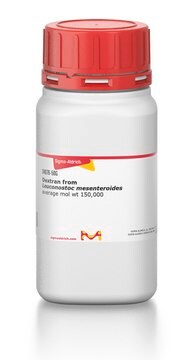181994
Poly(ethylene oxide)
average MV 200,000 (nominal), powder, hydroxyl, BHT as inhibitor
Synonym(s):
Polyethylene oxide, PEO
About This Item
Recommended Products
product name
Poly(ethylene oxide), average Mv 200,000 (nominal), powder
form
powder
mol wt
average Mv 200,000 (nominal)
contains
200-500 ppm BHT as inhibitor
viscosity
65-115 cP, 5 % in H2O(25 °C, Brookfield)(lit.)
transition temp
Tm 65 °C
Ω-end
hydroxyl
α-end
hydroxyl
application(s)
battery manufacturing
SMILES string
[H]OCCO
InChI
1S/C2H6O2/c3-1-2-4/h3-4H,1-2H2
InChI key
LYCAIKOWRPUZTN-UHFFFAOYSA-N
Looking for similar products? Visit Product Comparison Guide
General description
Application
This biocompatible polymer can be widely used in the field of biomedical research and tissue engineering. For example, it can be used in the fabrication of biodegradable polyurethane/graphene oxide scaffolds.
Storage Class Code
11 - Combustible Solids
WGK
WGK 1
Flash Point(F)
Not applicable
Flash Point(C)
Not applicable
Regulatory Listings
Regulatory Listings are mainly provided for chemical products. Only limited information can be provided here for non-chemical products. No entry means none of the components are listed. It is the user’s obligation to ensure the safe and legal use of the product.
JAN Code
181994-250G:
181994-BULK:
181994-VAR:
181994-500G:
181994-5G:
Choose from one of the most recent versions:
Already Own This Product?
Find documentation for the products that you have recently purchased in the Document Library.
Customers Also Viewed
Articles
Devising biomaterial scaffolds that are capable of recapitulating critical aspects of the complex extracellular nature of living tissues in a threedimensional (3D) fashion is a challenging requirement in the field of tissue engineering and regenerative medicine.
Our team of scientists has experience in all areas of research including Life Science, Material Science, Chemical Synthesis, Chromatography, Analytical and many others.
Contact Technical Service
